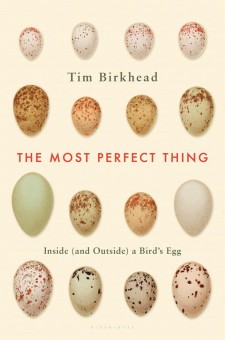Reviewed by Grant McCreary on July 15th, 2016.
Birders don’t think much about birds’ eggs. We just don’t come across them very often. We may have a field guide or use the internet to identify those that we do, on the rare occasion, find, but otherwise the extent of our knowledge of eggs ends at the breakfast table. Well, it does for me anyway. But this is a very important part, crucial even, of birds’ lives. And, as Tim Birkhead shows in The Most Perfect Thing: Inside (and Outside) a Bird’s Egg, also fascinating.
You may be wondering how in the world eggs could be interesting. There’s the shell, the egg white, and the yolk; it gets laid and so many days later a chick breaks out of it. But Birkhead systematically explains how much more there is to it, starting on the outside of the egg with the shell and working his way inward. This is a technical topic, to be sure, one that seems more appropriate in an ornithology textbook than a “mass market” book. Honestly, I’m not sure I would have been interested in it, except for the author.
The first book I read by Tim Birkhead was The Wisdom of Birds, a treatment on the history of ornithological concepts. That is a very big and – let’s be honest – potentially very boring subject. While the book is indeed pretty large, amazingly it is anything but boring. In fact, it is a great read. And I’ve found that to be true of all the author’s subsequent books, including The Most Perfect Thing. Perhaps that’s because they read more like a detective story than a textbook.
Birkhead also has an amazing ability to explain technical concepts in a clear, easy to understand, interesting manner. I could attempt to summarize the various topics he covers in this book, but I wouldn’t be able to do them justice. Instead, here are just a few of the interesting tidbits I discovered.
Egg shells have pores that allow the exchange of gases and water vapor. Studies have shown that “species breeding at high altitudes have fewer, smaller eggshell pores” as expected by the behavior of gases under different pressures. One would expect that the birds adapt to their local conditions, so that they always lay eggs appropriate for their usual elevation. But that’s not the case. When researchers had the same birds lay eggs at different altitudes, the birds produced eggshells whose pores differed accordingly. As Birkhead summarizes:
This discovery…is one of the most remarkable of all adaptations that birds exhibit. Just consider the possible mechanisms by which this comes about: the bird must be able to detect atmospheric pressure and somehow transmit that, via the brain, to the uterus where the shell is made, to create an eggshell with an appropriate number of pores. Extraordinary!
And did you know that chicks communicate with each other while still in eggs? This communication is “partly auditory and partly tactile” and is responsible for eggs – even those laid days apart – hatching within hours of each other.
And if that doesn’t do it for you, how about this: Birkhead informs the reader that “…until I started writing this book I hadn’t really appreciated the full impact that shit has played in the evolution of the guillemot’s breeding biology.” Who knew the study of eggs could be so interesting?
Recommendation
As you can see, The Most Perfect Thing: Inside (and Outside) a Bird’s Egg is not a dry, technically dense treatise. Quite the opposite, it is an interesting, comprehensible exploration of eggs. It will help anyone understand this “most perfect thing”. More than that, though, it gives a tantalizing taste of the exciting things just waiting to be discovered even about topics that we might, naïvely, consider mundane.
Disclosure: I get a small commission for purchases made through links in this post.
Buy from NHBS
(based in the U.K.)
Disclosure: The item reviewed here was a complementary review copy provided by the publisher. But the opinion expressed here is my own, it has not been influenced in any way.






Comment